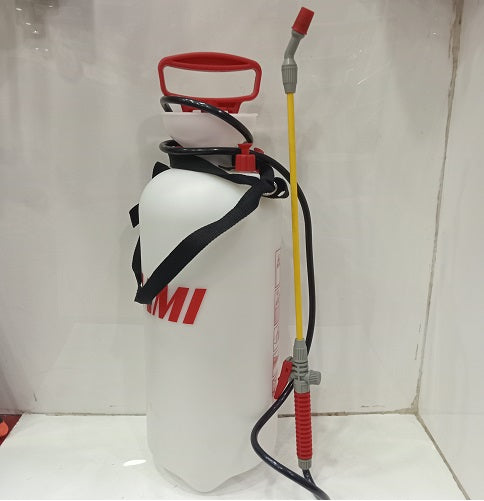Hami Hardware Store
AP-8 B Ltr
AP-8 B Ltr
Couldn't load pickup availability
An 8-liter sprayer can be a handy tool for various home and garden tasks, such as spraying pesticides, herbicides, fertilizers, or even just water for irrigation. Here's a basic guide on how to use an 8-liter sprayer for home use:
-
Read the Instructions: Always start by reading the manufacturer's instructions that come with the sprayer. Different sprayers may have specific features and requirements.
-
Safety Precautions: Wear appropriate protective gear, such as gloves and safety goggles, especially when handling chemicals.
-
Fill the Tank: Open the sprayer tank and fill it with the desired liquid. Be sure to use the correct dilution ratio for the substance you're applying. It's crucial to follow the recommended ratios to avoid over or under-application.
-
Pump Up the Pressure: Most hand-held sprayers require manual pumping to build pressure. Use the pump handle to pressurize the tank. Pump until you feel resistance, indicating that the tank is pressurized.
-
Adjust the Nozzle: Adjust the nozzle to control the spray pattern. Some common spray patterns include a fine mist, stream, or cone-shaped spray. The type of nozzle you use will depend on the task you're performing.
-
Spray: Aim the nozzle at your target and squeeze the trigger to start spraying. Move the sprayer evenly and at a consistent pace to ensure even coverage. Be mindful of the wind direction to avoid spraying unintended areas.
-
Re-pump as Needed: As you continue to use the sprayer, the pressure inside the tank may decrease. If you notice a decrease in spray pressure, stop and pump the sprayer a few times to restore pressure.
-
Rinse After Use: After using the sprayer, it's essential to thoroughly rinse it out to prevent any residue from damaging the components. Empty the tank and rinse it with clean water several times.
-
Store Properly: Store the sprayer in a cool, dry place, away from direct sunlight. Ensure that it's clean and dry to prevent corrosion and prolong its lifespan.
-
Maintenance: Regularly check for any damaged or worn-out parts, and replace them as needed. Lubricate moving parts as recommended by the manufacturer. This will help keep your sprayer in good working condition.
Remember that the specific instructions for your sprayer may vary, so always consult the user manual provided by the manufacturer. Additionally, make sure to follow any local regulations regarding the use of chemicals and pesticides, and use appropriate safety precautions when handling them.
Share










